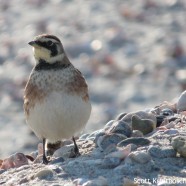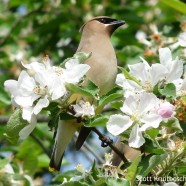Black-capped Chickadee (Poecile atricapillus) irruption
There have been Black-capped Chickadees (Poecile atricapillus) moving south in very subtle ways for a couple of months now. If you watch migratory hotspots you can sometimes detect their irruption years, especially if that location is not a particularly friendly habitat for the species. I have seen flocks of 10-20 birds tightly packed together and feeding on the move, possibly heading for a feeding station like yours. I always wonder what particular triggers end up notifying a widespread and highly adaptive bird like this one that they should nonetheless change their quarters for the autumn...
Read MoreHorned Lark (Eremophila alpestris)
The Horned Lark (Eremophila alpestris) is a species of open areas – the tundra, grasslands, fields, beaches and dunes and even the desert. Unsurprisingly they feed on the ground on insects and seeds and often take advantage of human activity disturbing areas such as mowed airports or piles of plowed earth or snow that expose more food. When it comes to the winter you will find them wherever it is the most bare. You can frequently spot them with Snow Buntings and, more rarely, the Lapland Longspur. They are also another species decreasing across much of their range and are listed as...
Read MoreButter butt season
We are now in the prime time for the butter butts: Yellow-rumped Warblers (Setophaga coronata). When you cannot see their behind they certainly look rather plain in October, like this individual. Nevertheless they are still a joy to watch pouring through our lands in sizable flocks and that distinctive flash of yellow we inevitably see is a reminder of the cold air on its way.
Read MoreCedar Waxwing (Bombycilla cedrorum)
Cedar Waxwings were suddenly everywhere in the last couple of weeks in WNY, as were blooming apple trees – a perfect combination.
Read MoreBonaparte’s Gulls (Chroicocephalus philadelphia) by Scott Kruitbosch
Hundreds of Bonaparte’s Gulls were in the Barcelona Harbor area in Westfield, NY on November 10, 2013. They frequently dove into the waters of Lake Erie to feed along with Double-crested Cormorant, Horned Grebe and other gull species. At least one rare Little Gull was in the mix. These small gulls fly and forage more like terns than gulls.
Read More








